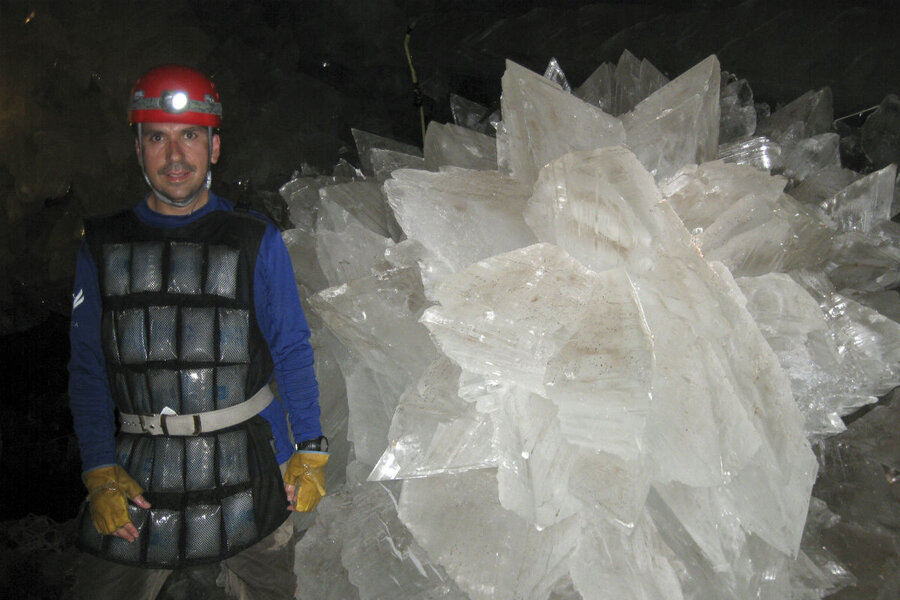Microbes wake up from 10,000-year nap in cave crystals
Loading...
A new find from otherworldly underground crystal caves raises hopes for finding life on, well, other worlds.
During exploration of Mexico’s inhospitable Naica caves, a team of scientists managed to extract, and revive, long dormant microbes from inside the giant crystals that populate the caverns. With genetic patterns unlike most other life on earth, the critters may have been dozing for many millennia.
If it holds up, the NASA-backed discovery would raise both hopes for finding life in the extreme environments of other worlds and fears of extraterrestrial contamination by hardy earthborn superbugs.
Like a real life Fortress of Solitude, the surreal Naica mine of Northern Mexico is riddled with crisscrossing translucent spikes dozens of feet in length. Originally developed by miners hunting for silver and other precious metals, the site also attracted scientists interested in extremophiles – life forms that thrive in often oxygen-free intense environments of fire and ice: deep sea vents, antarctic ice, and volcanoes.
Located nearly a thousand feet underground, exploring the Naica caves is not for the faint of heart. Even specially developed ice-suits equipped with ventilators piping in ice-cooled air only permitted human visitors to brave the sweltering temperatures for an hour at a time.
But for the chemosynthesizing microbes that call this hot, pitch black cave home, it’s no big deal. Unlike most familiar ecosystems that ultimately derive their energy from sunlight, life forms in these dark environments break down rock minerals for food like little miners.
Researchers already knew microbes lived in the caves, but no one suspected they might actually be lurking inside imperfections in crystals themselves, some of which date back millions of years.
In 2008 and 2009, the team succeeded in recovering microbes holed up in small pockets of crystal encased fluid by drilling with sterilized drill bits, and then reanimated them back in the lab. Based on estimates of how fast crystals grow, the tiny time travelers could be between 10,000 and 50,000 years old.
Director of NASA's Astrobiology Institute Penelope Boston announced the team’s findings at the annual meeting of the American Association for the Advancement of Science in Boston on Friday.
“These organisms have been dormant but viable for geologically significant periods of time, and they can be released due to other geological processes,” she said. “This has profound effects on how we try to understand the evolutionary history of microbial life on this planet.”
Ancient life forms hibernating in salt, ice, or crystal are nothing new. “Reviving microbes from samples of 10,000 to 50,000 years is not that outlandish based on previous reports of microbial resuscitations in geological materials hundreds of thousands to millions of years old,” Brent Christner, a microbiologist at the University of Florida in Gainesville, told National Geographic.
But such claims have typically been met with skepticism. Even hibernating organisms need some energy, and slowing their metabolism enough to permit suspension on geological timescales may be impossible.
“I think that the presence of microbes trapped within fluid inclusions in Naica crystals is in principle possible. However, that they are viable after 10,000 to 50,000 years is more questionable,” said microbiologist Purificación López-García of the French National Center for Scientific Research to National Geographic.
Skeptics suggest the microbes could have hitched a ride on the drill bits, making it look like they were inside the crystals the whole time. The team is in the process of publishing their results, which have not yet been peer reviewed.
But Dr. Boston says her find has made her a believer. She notes that the team took great care to sterilize both their tools and the surfaces of the crystals themselves with chemicals and fire.
Moreover, the genetics backs them up, according to Boston. “Other people have made longer-term claims for the antiquity of organisms that were still alive, but in this case these organisms are all very extraordinary – they are not very closely related to anything in the known genetic databases."
She also sees fingerprints of isolation in the way the microbes interact with local viruses. "Other groups have shown there are lots of viruses in these caves and what that says to me is that these are fully fledged microbial communities that have their viral load just like every other community does. So, that's another aspect of this that argues against casual contamination," she told reporters.
With the building blocks of life showing up all over the solar system, the existence of these reclusive life forms makes scientists wonder if similar microbes could be alive somewhere underneath the inhospitable surfaces of other worlds, hidden from the prying eyes of orbiting probes and rolling rovers.
"The astrobiological link is obvious in that any extremophile system that we're studying allows us to push the envelope of life further on Earth, and we add it to this atlas of possibilities that we can apply to different planetary settings."
But the discovery also raises concerns that any extraterrestrial find could actually turn out to be terrestrial hitchhikers.
“How do we ensure that life-detection missions are going to detect true Mars life or life from icy worlds rather than our life?” Boston asks. “Aspects of my work illustrate the extreme toughness of life on Earth and the restrictions that places on us.”
Just launching a probe into the vacuum of space was once thought to be enough to zap any riders, but we already have direct evidence to the contrary.
Boston hopes the evidence her team has gathered will be sufficient to prove their case, because returning to the caves, which she called “tear-inducingly beautiful,” is impossible. After becoming unprofitable, the mine was allowed to be flooded with groundwater, returning to its natural state.
The crystals will resume their growth, perhaps trapping more microbes to puzzle scientists of the distant future.








